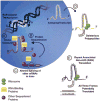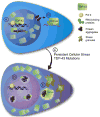Neurodegeneration the RNA way
- PMID: 22079416
- PMCID: PMC3582174
- DOI: 10.1016/j.pneurobio.2011.10.006
Neurodegeneration the RNA way
Abstract
The expression, processing, transport and activities of both coding and non-coding RNAs play critical roles in normal neuronal function and differentiation. Over the past decade, these same pathways have come under scrutiny as potential contributors to neurodegenerative disease. Here we focus broadly on the roles of RNA and RNA processing in neurodegeneration. We first discuss a set of "RNAopathies", where non-coding repeat expansions drive pathogenesis through a surprisingly diverse set of mechanisms. We next explore an emerging class of "RNA binding proteinopathies" where redistribution and aggregation of the RNA binding proteins TDP-43 or FUS contribute to a potentially broad range of neurodegenerative disorders. Lastly, we delve into the potential contributions of alterations in both short and long non-coding RNAs to neurodegenerative illness.
Copyright © 2011 Elsevier Ltd. All rights reserved.
Figures


References
-
- Arai T, Mackenzie IR, et al. Phosphorylated TDP-43 in Alzheimer's disease and dementia with Lewy bodies. Acta Neuropathol. 2009;117(2):125–136. - PubMed
-
- Arocena DG, Iwahashi CK, et al. Induction of inclusion formation and disruption of lamin A/C structure by premutation CGG-repeat RNA in human cultured neural cells. Hum Mol Genet. 2005;14(23):3661–3671. - PubMed
-
- Asikainen S, Rudgalvyte M, et al. Global microRNA expression profiling of Caenorhabditis elegans Parkinson's disease models. J Mol Neurosci. 2010;41(1):210–218. - PubMed
Publication types
MeSH terms
Substances
Grants and funding
LinkOut - more resources
Full Text Sources
Medical
Miscellaneous

